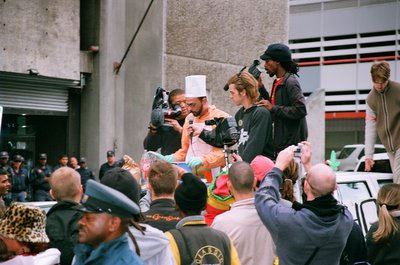Cape Town - When Nomanindia Mfeketo was Cape Town mayor she made a commitment that within a year there would be no more children sleeping on the city’s streets.
That was in 2004 and, as she later acknowledged, the problem was a lot more complex than she had originally realised.
There have been a number of efforts since then to reduce the number of homeless people on the streets.
Before the World Cup in 2010, NGOs accused the city of rounding up street children and the homeless and dumping them at Blikkiesdorp near Delft. The city denies this, though, saying Blikkiesdorp was established as a Temporary Relocation Area in 2008 to house people who were evicted after invading N2 Gateway houses.
And last year there was a talk of the establishment of “community villages” outside the city centre where people could live and have access to skills training and drug rehabilitation programmes.
Greg Andrews, convener of the Street People’s Forum, said this proposal had since been canned.
The forum is a collective of several organisations working with street people in the city.
Andrews said the city’s “community village” idea was a perennial proposal that had surfaced in many guises over the last two decades.
“Even if such a community village were established, why would people want to go there? Would they be compelled against their will?
“On the other hand, perhaps it would be a really attractive proposition which someone on the streets would love to go to, in which case why would people leave once they have entered?”
Hassan Khan, chief executive of the Haven Night Shelter, believes the streets are no place for people to live.
“The streets should be a cold place, a place where you are hungry, so people come for help.”
But he says people are given permission to be there by politicians and some encouraged by NGOs who go out and give blankets and food to the poor.
“People are pre-programmed to help. They also pay someone just to be left alone.”
Not that he believes that poverty should be policed like the CCID with their private armies who force people to the edge of the CBD.
Khan said there were an increasing number of people coming to the streets, mainly adults.
“There are guys in their 50s from Welkom who have worked their whole lives in the Post Office and are virtually unemployable now.”
There is a large gay population, people who are not accepted by their families, and youngsters lured by the bright city lights.
“The important thing is how quickly a child on the street is identified and helped. The same with adults.”
Zara Nicholson, spokeswoman for mayor Patricia de Lille, said the City of Cape Town was the first city in the country to have adopted a policy for people living on the street.
“The city’s strategy is to reduce the number of people living on the street and to place them back with their families and communities of origin.”
Part of this reintegration effort included attempts to secure employment opportunities via the Expanded Public Works Programme.
Nicholson said that street people could not, however, be forced into accepting the city’s offers of assistance.
The City of Cape Town’s Reintegration Unit, launched in December, had successfully assisted 85 street people in its first three months of operation.
The city is also in the final phase of its Street People Survey which would include conducting a headcount of street people. The last comprehensive survey conducted by the city was in 2001 and there are estimates that there are around 7 000 transient people either living or begging on the street (across the whole city).
Councillor Suzette Little, the city’s mayoral committee member for social development and early childhood development announced recently that the city had nearly doubled its budget for its winter street people programme this year. The budget for the 2014 programme was R280 000, but this year R600 000 had been allocated.
Little said they also ran a number of programmes in communities most at risk to prevent more people migrating to the streets.
“These programmes are focused on issues in the home, truancy and substance abuse and to provide support to street people who are reintegrated into their communities to prevent a return to their former life.”
But Andrews doesn’t believe the city’s Street People Policy is actually effective.
“The central aim of its current policy boils down to the removal of people from the streets, though this is couched in gentle terms like ‘reintegration’ and ‘reunification’ so it’s quite palatable.”
But he explains that reunification or reintegration only worked if it was self-determined.
“Take for instance the typical example of someone who has come to the city centre desperate for work. Precious few opportunities exist and eventually he either is begging or parking cars, scrounging a pittance any way he can.
“Even if he never makes enough money to support his family, at least he feels he is not a burden to them – another mouth to feed, a body taking up precious space.
“But sometimes, he may be able to get a bag of groceries back home, maybe for someone’s birthday or for Christmas. Now the city’s Reintegration worker finally compels this man to go home.
“Imagine the shame of being escorted home by the larney from the welfare with nothing to support your family and them being told they must look after you. This is not sustainable.”
Andrews believes reintegration was only possible once the “40 percent unemployment and intractable brutal violence” that characterises daily life in the home communities that people on the streets run away from, are addressed.
“Furthermore, we need to address the bottleneck of over-full shelters, over-stretched services and inadequate social housing. Reintegration is meaningless when we have nothing to reintegrate a person into.”
Andrews says it would be refreshing if the city were to admit that people on the streets are not the problem and they’re not going away any time soon.
“The real problem is that 20 years into freedom, poverty is worse and it’s high time we stop trying to remove the poor from our well-to-do areas just because they make us feel uncomfortable or threaten our illusion of security.”
helen.bamford@inl.co.za
-
Cape Argus

 Peacefully Demonstrated outside the Department of Housing May 7 2005
Peacefully Demonstrated outside the Department of Housing May 7 2005









